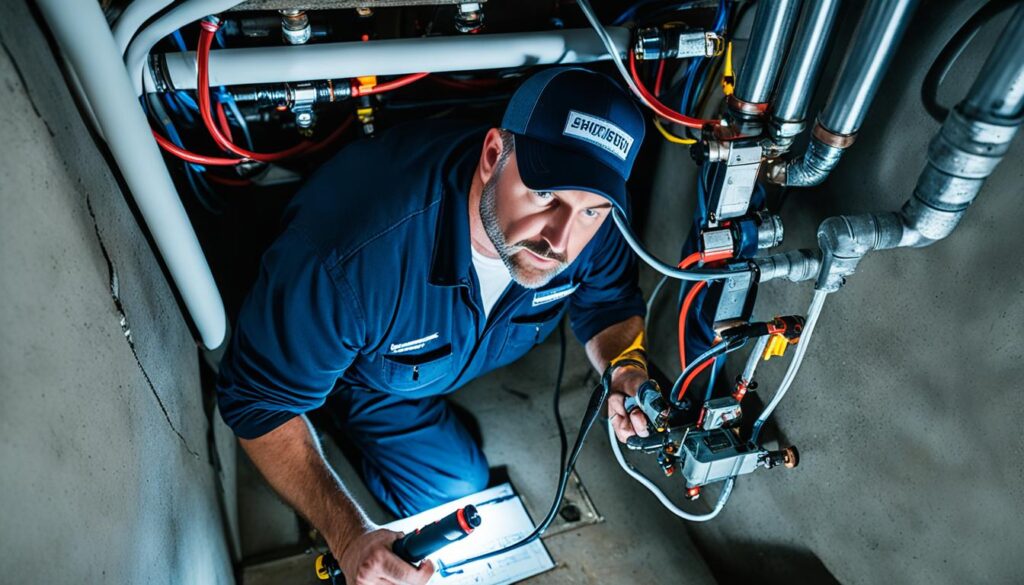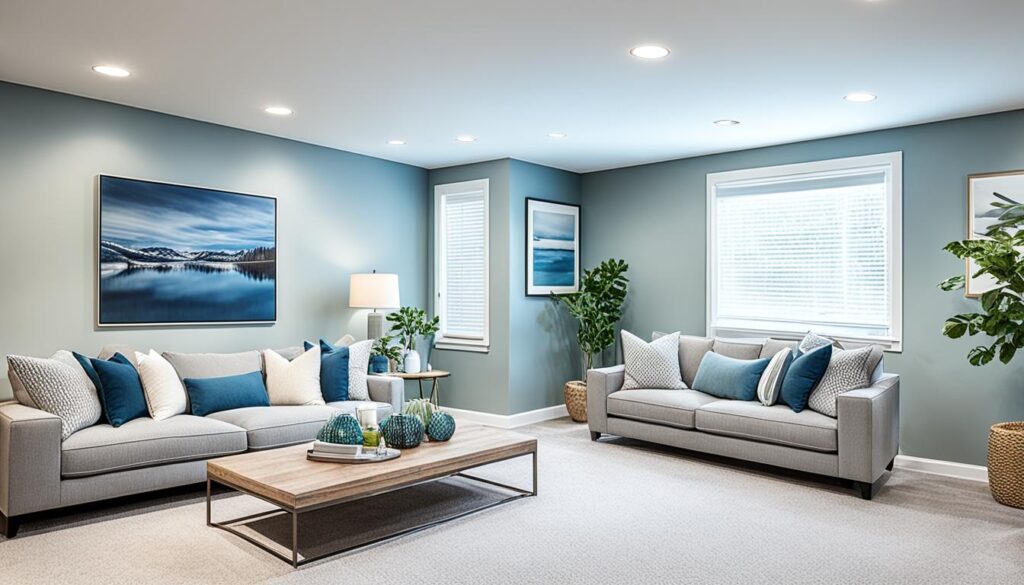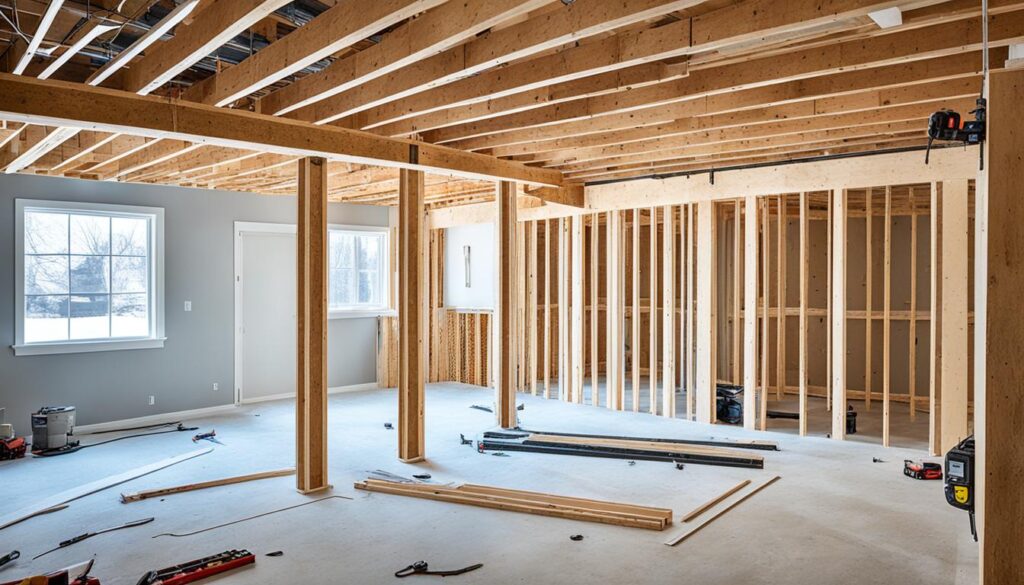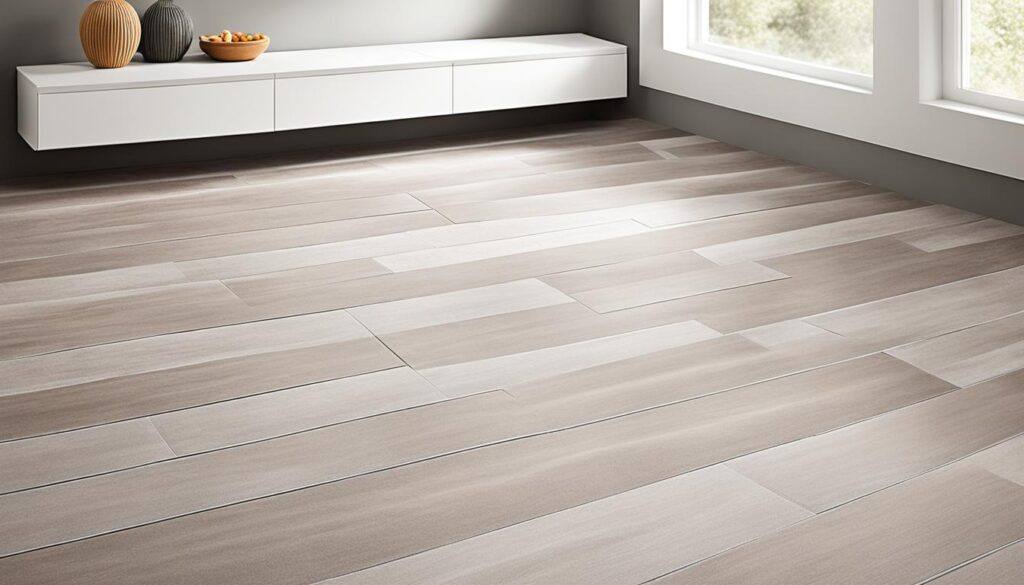Do you have an unfinished basement at home? It’s a space full of potential for comfort and productivity. According to experts, this area can become a valuable asset. There are many ways to change it into a room that boosts your home’s use and attractiveness.1 The main issue with basements is the risk of mold due to dampness. But this is often fixable with better ventilation.1
Finishing your basement takes careful thought and the right choices. You need to measure the space, check plumbing and wiring, and ensure it’s well insulated and protected from moisture.2 This effort is crucial to turn your basement into a cozy, functional, and beautiful area.1 Also, experts say that remodeling your basement can boost your home’s value by 77.6%. So, it’s a smart move for your property.1
Key Takeaways
- Basements can be transformed into productive living spaces with the right renovation strategies.
- Addressing moisture issues and ensuring proper ventilation are crucial for a successful basement remodel.
- Careful planning, including measuring the space and inspecting plumbing and wiring, is essential for a seamless basement transformation.
- Basement remodeling can provide a significant return on investment, making it a valuable home improvement project.
- Leveraging innovative design ideas and incorporating personal style can create a unique and functional basement living area.
Measure Your Basement
Starting a basement remodeling project? It’s key to measure the space right.3 With over three thousand projects behind me, I know how crucial this step is. A simple tape measure or a tool like the Bosch 165′ LASER DISTANCE MEASURING device can help. It costs about $80 or more.3
Know the Height Requirements
Local building codes require a minimum of seven feet basement height for it to be livable.3 It’s important to measure your basement’s height accurately. This measurement decides your remodeling options. If your basement is too short, you might need to adjust floors or ceilings. This helps fulfill safety codes and make the area comfortable.
Consult Local Building Codes
Measuring your basement is not enough. Reviewing local building codes is also vital.4 It ensures your remodeling plans are legal and inspection-friendly.4 It’s necessary to check the entire space against these laws. This can help you avoid problems and extra costs later on.
Inspect Plumbing and Wiring
When turning an unfinished basement into a new room, checking plumbing and wiring is key.5 Make sure they match the required standards.5 Basements must be at least 7 feet high to turn into living spaces.5
If your basement needs a bathroom or more lights, inspections are a must.5 You’ll likely need to add new plumbing and wiring.5
Upgrade Existing Systems
If there’s already plumbing or wiring in your basement, get them checked.5 This ensures they’re safe and work well.5 Make any upgrades needed for a better space.5
Obtain Necessary Permits
Always get permits before any plumbing or electrical work.6 Pros should handle these tasks.6 Without permits, insurance might not cover you and you could face fines.6

Add Insulation for Warmth and Sound
Insulation is key for making a basement into a cozy space. It keeps the area warm in winter.7 It’s also great at cutting out noise to give you peace and quiet.7
Use Insulated Panels and Batting
For a basement that’s both warm and quiet, try insulated panels or batting.7 Vinyl-faced fiberglass is perfect for inside walls without a frame.7 EcoCell Cellulose Blanket is great too, offering a high R-10 value.7
Consider Wall Renovation Options
If your home is older and lacks insulation, you’ll want to add it. This helps meet energy codes and improves sound and fire safety.7 Look into mineral wool like RockWool for better insulation properties. It also dampens sound well.7 For a green choice, consider blown cellulose insulation too. It’s better for sound and offers a high R-value.7
To make your basement truly soundproof, try blown cellulose. But for it to work best, you’ll need to finish the ceiling with drywall.7
Don’t forget about the local building codes when you renovate. They’ll likely require a certain level of insulation.8 Also, think about the basement size and insulation cost. This matters in your decision-making.8
Choosing the right insulation makes your basement warm, quiet, and efficient. This improves how you live in your home.78
https://www.youtube.com/watch?v=HPLhXrwQQck
Add Moisture Protection
Turning a basement into a new room means you need to think about moisture protection. This ensures the area stays safe and comfy.9 One expert says you should use vapor barriers to stop moisture from the concrete walls. This is key if you plan to live in the basement.10 Another source agrees. They highlight that adding vapor barriers is crucial for turning your basement into a living space.
Install Vapor Barriers
For good moisture defense, installing vapor barriers is a must.11 One source recommends a 6 mil thick vapor barrier on the basement walls. Plus, use unfaced insulation to avoid trapping moisture. This is especially important in cold areas to prevent mold.11 Instead of regular fiberglass, consider using extruded polystyrene insulation. It acts as both insulation and a vapor barrier. This keeps your basement warmer and drier.
Basement Living Room Ideas
Creating a basement living room that’s cozy starts with excellent moisture protection.9 One tip is to make a vapor barrier with an air gap, using a product like DMX 1-step for the floor.9 The same advice recommends spray-foaming the underlayment and considering how it connects to the walls. This ensures your room is fully protected from moisture and vapor.

Install Proper Egress Windows
Turning your basement into a living area means you must install the right egress windows. These windows do more than just bring in light. They are vital for escaping in case of a fire or other emergencies.12 An Egress window’s bottom can’t be more than 44 inches from the floor. Its opening must be at least 5.7 square feet.12
Allow for Emergency Escape
Egress windows are key for safety, making sure everyone has a way out if needed.12 They should open to at least 4% of the room’s size and the glass part needs to be 8%.12 Imagine a basement bedroom that’s 300 square feet. Its window would need to open to 12 square feet with 24 square feet of glass.12
Expand Window Spaces if Necessary
Sometimes, you may need to make the window areas bigger and update the foundation.13 An egress window needs an opening of 5.7 square feet, with at least 24 inches high and 20 inches wide.13 If the window well deepens beyond 44 inches, the ladder part must stick out no more than 6 inches into it.13
13 The covers on egress windows should be easy to remove, not needing special tools. This makes sure getting out is simple in an emergency.13 Adding an egress window can raise your home’s value by $21,400. And making a basement bedroom legal is like having that space above ground, almost doubling your home’s value.13
13 The house prices in the area averaged $122 per square foot. With the extra room at 350 square feet, its resale value went up by $21,350.13 An egress window is seen as a value-adding feature, promising and often giving a better than full return on investment, proof shows.13
Include Proper Ventilation
Having good basement ventilation is key. It keeps the air flowing and the area nice. Setting up ventilation in a basement can range from using a simple fan that costs about $50 to putting in an HVAC system for about $12,500.14 This is important for removing bad smells or gases.
More air movement and avoiding bad smells are big reasons for good basement ventilation. Adding proper ventilation is crucial during basement makeovers.
| Ventilation Solution | Cost Range |
|---|---|
| Box Fan | $50 |
| HVAC System Installation | $12,500 |
| Dehumidifier | $800 – $2,000 |
| Central Air Conditioning | $5,000 – $12,500 |
| Exhaust Fan | $50 – $250 |
It’s smart to keep basement humidity under 60% to stop mold.14 Right ventilation makes the space comfy and safe.

Basement Remodeling
Starting a basement remodeling job can pay off well. Studies show it can give back 77.6% of what you spent.15 But, it’s important to look out for dangers like radon. Radon is a dangerous, invisible gas found in basements.
Check for Radon
Radon can enter your home unseen. It comes through tiny cracks in the foundation. It can lead to lung cancer. This is why it’s vital to check for radon before remodeling.
Use Radon Test Kits
For a safe basement, test it for radon. Radon test kits are easy to find. They help you know if there’s a problem. This step is crucial before a remodel begins.
Check for Pests and Rot
Before you start updating your basement, make sure to look closely at the wood, stone, and concrete. Look for Basement Pest Inspection and Basement Rot Inspection signs. Fixing these issues early is key. They affect the basement’s strength and your safety.
Inspect Wood, Stone, and Concrete
Check the wood, stone, and concrete for water damage, mold, or pests. Doing a Basement Rot Inspection helps you find what needs fixing. Look carefully in hidden spots like corners, under structures, and inside walls. These places might have unwanted guests or damage.
Replace Damaged Materials
If you find materials in bad shape, like wood, stone, or concrete, swap them out. Quick replacement keeps your renovation safe and long-lasting. Some instances call for Basement Material Replacement to prevent moisture, pests, or structural problems. These can harm your remodel.

Install Durable Walls
When you make your basement a living area, the walls are key. Instead of usual drywall, try using tougher basement wall materials. These materials can handle the basement’s special needs well.16
Use Moisture-Resistant Materials
Basements often get moist, causing mold and mildew. That’s why you should use moisture-resistant walls. These keep walls dry in wet conditions. Wall panels and foam boards work great to stop moisture.
Add Framing for Insulation
Don’t forget about framing and insulation for basement walls. The right frame keeps walls strong. It also lets you add insulation. Insulation helps control temperature and makes the basement a cozy space.

Upgrade Flooring
Choosing the right flooring for your basement is key for making it liveable.17 Classic hardwood is risky in basements because it can soak up moisture and warp. Instead, think about using engineered wood flooring or basement tile flooring. These options are better for below ground spaces.
Consider Engineered Wood or Tiles
17 Engineered wood is better at resisting water damage than regular wood. This makes it a smart pick for basement floors.17 Porcelain tiles are also a good choice. They look great and keep moisture out.17 Check out these basement flooring options for a beautiful, long-lasting floor in your basement.
Avoid Bare Concrete
Don’t settle for bare concrete floors in your basement. They make the space look dull. Going for better flooring, like the ones we talked about, improves how the basement feels and looks. Choosing the right flooring matters a lot. It affects how cozy and useful your basement is.

Conclusion
Turning an empty basement into a cozy space can make a big difference. You start by checking the area and fixing any plumbing or wires. Then, you make sure it’s dry, warm, and has fresh air. After that, you get to pick out new walls and floors. Doing this can add comfort and value to your home.
It’s a wise choice because it gives homeowners back almost 78% of what they spent. Plus, fixing up the basement means less energy used and lower bills.18 When it’s time to sell, this effort can pay off a lot by making the house more valuable.
If you dream of a new living room or a cool workspace, the basement is key. With experts like ElkStone Basements in Colorado Springs, you can easily achieve your goals. They specialize in finishing basements, helping you turn your basement into any room you want.18
FAQ
What are the common problems a basement faces, and how can they be addressed?
Mild dampness often leads to mold, mildew, and fungi in basements. A solution is upgrading the ventilation or installing a new system.
What are the key considerations for basement remodeling?
Key things for basement finishing include space measurement and checking plumbing and wiring. Adding insulation and moisture guard is also essential.
What is the typical return on investment for basement remodeling?
Basement remodeling returns about 77.6% on your investment. It’s a valuable home improvement.
What is the minimum height requirement for a livable basement?
For a basement to be livable, most codes ask for a minimum height of seven feet.
What should be done with existing plumbing and wiring in the basement?
If it already has plumbing or wiring, check if they’re up to code. Install them if they’re missing.
Why is installing insulation crucial for a basement?
Insulation keeps the basement warm in winter. It also blocks noise from escaping into the rest of the house.
What is the importance of adding vapor barriers in a basement?
Adding vapor barriers keeps moisture from creeping through the concrete walls in basements.
Why are egress windows necessary for a basement?
Egress windows allow natural light and are vital exits during an emergency, like a fire.
What is the importance of proper ventilation in a basement?
Right ventilation keeps the basement’s air fresh. It also removes any harmful fumes from inside.
How can radon be addressed in a basement remodeling project?
To make a basement safe, first, do a radon test with a kit. This is crucial before any remodeling step.
What should be done to address any pests or moisture damage in the basement?
Before remodeling, tackle any pest or moisture issues in the wood, stone, or concrete.
What types of materials are recommended for basement walls and flooring?
Choose sturdy materials for walls, steering clear of drywall. Wall panels and foam boards are better. Avoid usual wood floors; they warp with moisture. Opt for engineered wood, tile, or well-fixed carpet.
Source Links
- https://elkstonebasements.com/how-to-transform-your-basement-into-a-living-space-7-steps/
- https://southmetroremodel.com/20-creative-basement-remodel-ideas-to-transform-your-space/
- https://basementdesigner.com/how-to-measure-your-basement-for-design/
- https://www.bankrate.com/homeownership/cost-to-finish-basement/
- https://www.familyhandyman.com/list/basement-finishing-tips/
- https://ask.metafilter.com/40545/I-never-got-my-basment-inspected-Should-I
- https://www.redcloudcontracting.com/uncategorized/what-to-do-about-insulation-in-a-basement/
- https://www.greenbuildingadvisor.com/question/another-how-should-i-insulate-my-basement-question
- https://www.greenbuildingadvisor.com/question/best-floor-wall-assembly-for-basement-to-manage-moisture
- https://www.basementsystemsusa.com/basement-waterproofing/finishing-a-basement.html
- https://forum.nachi.org/t/basement-vapor-barrier/36301
- https://www.breyerconstruction.com/blog/finishing-your-basement-understand-egress-window-requirements/
- https://makingprettyspaces.com/2021/08/11/adding-an-egress-window-in-our-basement-all-the-details-including-cost-value-added/
- https://www.angi.com/articles/how-improve-ventilation-basement-remodeling-project.htm
- https://basementremodeling.com/
- https://www.revivalwoods.com/blog/2017/5/11/how-to-finish-a-basement-on-a-budget
- https://bigyeti.builders/the-best-flooring-options-for-your-basement-remodel/
- https://elkstonebasements.com/4-reasons-you-should-finish-your-basement-this-year/
